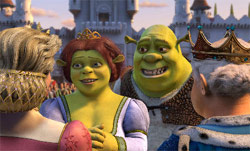
| HOME |
| NERVE |
| REVIEWS |
| ARCHIVE |
| EVENTS |
| LINKS |
| ABOUT US |
| CONTRIBUTORS |
| BACK ISSUES |
| CONTACT US |
 Shrek
2 (U)
Shrek
2 (U)
Directed by Andrew Adamson
On general release from 2nd July 2004
Reviewed by Tim Kopp
This conservative sequel to Shrek profits from terrific visuals, stronger pacing and some solid gags, but even more so than in the original, the strategy of spoofing fairytale routines and quoting film classics is still too topical and self-consciously clever to give the film timeless appeal.
Shortly after arriving home in the swamp from their honeymoon, Shrek and his wife Fiona receive an invitation from her parents, the King and Queen of Far Far Away, to celebrate the marriage. Joined by Donkey, the couple travel there but relations between Shrek and his father-in-law quickly hit rock bottom when the King makes no secret of his contempt for Shrek. Shrek’s problems are further compounded when the kingdom’s Fairy Godmother learns of the marriage and gets determined to reunite Fiona by any means with her son, the good-looking but insipid Prince Charming.
Essentially repeating the original’s routine of gag-and reference-filled satire, Shrek 2 is offering little in the way of new ideas, but judging by the record-breaking grosses at the US box office and the reactions of the family crowd during the preview screening, the film ostensibly succeeds in satisfying its key audience. Yet its method of quoting classics and more recent cult films becomes progressively more tedious: when the picture cannot think of anything better for Shrek and Fiona’s honeymoon sequence than to cite Burt Lancaster and Deborah Kerr’s famous love-making-on-the-beach scene from Fred Zinnemann’s From Here To Eternity (as if that film hadn’t been referenced to death already), it’s a sign of how conventional Shrek 2 is. Successive nods to Peter Jackson’s Lord of the Rings trilogy (Shrek and Fiona exchanging wedding rings copies a scene from The Fellowship of the Ring shot-for-shot), the first Mission Impossible and a joking imitation of the birth in Ridley Scott’s Alien are likewise not only too deliberate and knowing in their ironic, post-modern context but also representative of the film’s lack of novelty.
Even more so than its predecessor, Shrek 2 seems to be trying too hard to comment on, and cover all that is renowned and celebrated in popular culture, and in doing so, attempting to make us believe that in itself it is worthwhile, too. This should account then for the decision not only to cast Antonio Banderas as the fencing cat Puss-in-Boots, a character based on, and a parody of his Zorro character, but to hammer the point home with yet more winks to The Mask of Zorro. Banderas is excellent, however, and his scenes comprise the majority of the picture’s standout moments. Murphy’s Donkey provides additional if somewhat hit-and-miss comedy but apart from Banderas, only John Cleese’s King leaves a lasting impression in terms of characterisation and voice acting.
Visually, Shrek 2 is yet again a showcase for the advances in CGI, with
progress being most notable in body and facial animation: in particular
the King’s range of emotions and facial expressions is awe-inspiringly
realistic. But while there are some pleasures to be had, the picture still
feels simultaneously overstuffed and short on ideas, and indulging in
its worst moments in kitsch and empty pastiche. Stronger pacing and advanced
visuals notwithstanding, and only fitfully amusing, Shrek 2 is simply
content to repeat the old trick which will only add to the sense of diminishing
returns for anyone impartial to the franchise.